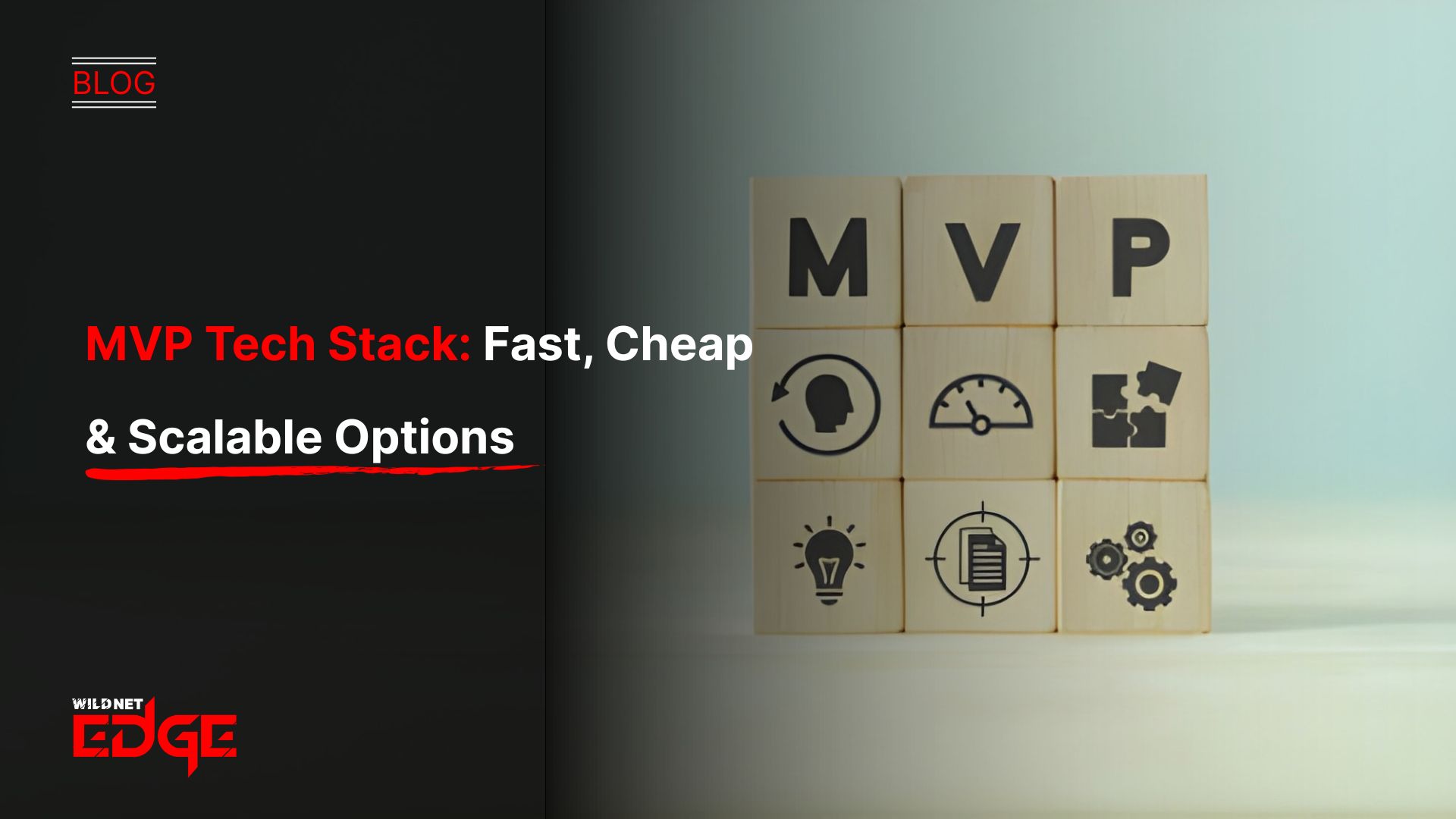TL;DR
This article helps founders choose the right MVP tech stack by balancing speed, cost, and scalability. It highlights how technology choices affect launch time and iteration ability. The guide covers key factors like project needs, team expertise, and performance, and reviews popular MVP stacks such as React/Node.js, Python/Django, and Ruby on Rails. It emphasizes that while speed matters, building a scalable MVP architecture early prevents future technical debt and sets the foundation for long-term success.
For a startup founder, the Minimum Viable Product is the crucial first step towards validating a business idea. But bringing even a minimal product to life requires making critical technology decisions. Choosing the right MVP tech stack, the collection of programming languages, frameworks, databases, and tools, is a balancing act. You need technologies that allow for rapid development and cost-efficiency now, but also provide a foundation that won’t cripple your ability to scale later. Getting this balance right is fundamental to a successful launch and sustainable growth.
What is an MVP Tech Stack?
An MVP tech stack is the specific combination of technologies selected to build the initial, core version of your product. Unlike the potentially complex stack of a mature application, the MVP stack prioritizes:
- Speed of Development: What is the time frame for building and launching the necessary features?
- Cost-Effectiveness: In which ways can we shrink the initial payments and put in place the economical instruments that are often open-source?
- Sufficient Scalability: The system should permit a reasonable increase in users without immediate bottlenecks even if it does not need to support millions of users at the beginning.
- Ease of Iteration: How difficult is it to change and add features according to the feedback of early users?
Choosing the right startup MVP technology is about finding the optimal intersection of these priorities for your specific product and market.
Why Your MVP Tech Stack Choice is Critical
This early technical decision has far-reaching consequences:
- Time-to-Market: Choosing the wrong technology can be a major cause of slow down in development process, and as a result, your launch is delayed and your runway is consumed.
- Development Costs: The use of complex or obscure technologies means that the cost of hiring developers will be highest. On the other hand, the utilization of open-source stacks with a large community will probably be more economical.
- Ability to Iterate: One stack is more receptive to changes and feedback than the other. Flexibility is crucial during MVP period.
- Scalability Foundation: Even though the MVP is not the final product, developing on an inherently non-scalable stack can lead to the accumulation of vast technical debt that will inevitably force rewrites at an expensive stage. Designing a scalable MVP architecture is imperative.
- Hiring: An attractive modern stack would be a good option for your company if you want to be able to easily hire new developers in line with your company growth.
Factors to Consider When Choosing the Best Stack for MVP
There’s no single “perfect” MVP tech stack. The ideal choice depends on several factors unique to your startup.
1. Project Type and Core Requirements
What does your MVP actually do?
- Content-Heavy Site/Blog: A CMS like WordPress (PHP/MySQL) might be fastest.
- Standard Web App (CRUD): Frameworks like Ruby on Rails, Node.js/Express, or Python/Django offer rapid development.
- Real-Time Features (e.g., Chat): Node.js excels here.
- Data-Intensive/AI/ML: Python is often the preferred choice due to its rich ecosystem.
- Cross-Platform Mobile App: Flutter or React Native are strong contenders for reaching iOS and Android quickly.
2. Team Expertise (or Lack Thereof)
If you have a founding technical team, leveraging their existing expertise can accelerate development significantly. However, don’t let existing skills dictate a poor long-term choice. If you are outsourcing or hiring, choose a stack with a healthy talent pool. Planning the right team structure often requires considering custom software architecture services.
3. Need for Speed vs. Long-Term Scalability
While speed is paramount for an MVP, completely ignoring scalability is dangerous. Aim for a stack that offers a good balance. Many startup MVP design are made for both rapid development and scalability (e.g., using cloud-native principles).
4. Third-Party Integrations
Does your MVP rely heavily on specific third-party APIs (e.g., payment gateways, mapping services)? Ensure your chosen stack has good support and libraries for these integrations.
Popular MVP Tech Stack Options in 2026
Here are some common and effective combinations:
- Node.js + React/Vue/Angular + PostgreSQL/MongoDB: (MERN/MEAN/MEVN variations) Very popular due to JavaScript ubiquity, large community, and suitability for real-time features. Excellent for web apps.
- Python + Django/Flask + PostgreSQL: Strong choice for data-intensive applications, AI/ML features, and rapid backend development. Mature and scalable.
- Ruby on Rails + PostgreSQL: Famous for its convention-over-configuration approach, enabling extremely fast initial development. Still a solid choice for many MVPs.
- PHP + Laravel + MySQL: A mature, widely used stack, particularly strong for web applications with a large ecosystem.
- Flutter/Dart or React Native (JavaScript) + Firebase/Supabase: Excellent choices for cross-platform mobile app MVPs, offering rapid development and integrated backend-as-a-service options.
Choosing the right infrastructure partner is also key. Effective DevOps & cloud setup for startups ensures your chosen stack can be deployed and scaled efficiently.
MVP Stack Selection in Action: Case Studies
Rapid MVP Launch with React Native and Firebase
- The Challenge: A startup needed to launch a social networking MVP extremely quickly to test user engagement loops before a competitor launched.
- The Stack Choice: They opted for React Native for the cross-platform mobile app and Firebase for the backend. Firebase (BaaS) eliminated the need for complex backend setup initially, allowing the team to focus solely on the frontend user experience.
- The Result: The MVP launched in under 3 months. The BaaS backend handled initial user load adequately, allowing them to gather crucial validation data. They later migrated to a custom backend once core features were proven.
Case Study 2: Scalable MVP Architecture with Django, PostgreSQL, and React
- The Challenge: A B2B startup’s core value proposition involved complex data analysis and reporting. Scalability and data processing power were key concerns from day one.
- The Stack Choice: They chose Python (Django) for the backend due to its strong data science libraries, PostgreSQL for its robust relational data handling, and React for the interactive frontend dashboard. The technical architecture for MVPs focused on a clean API design.
- The Result: While the initial build took slightly longer than a simpler stack might have, the chosen technologies provided a solid foundation. The platform could handle complex queries efficiently, and the architecture allowed for seamless scaling as data volumes grew post-launch.
Our Technology Stack Expertise
We focus on modern, scalable, and efficient technologies ideal for startups.
- Frontend: React, Vue.js, Angular, Flutter
- Backend: Node.js, Python, Ruby on Rails, Go
- Databases: PostgreSQL, MongoDB, MySQL, Firebase Firestore
- Cloud: AWS, Google Cloud, Azure, Heroku, Vercel, Firebase
- DevOps: Docker, Serverless, Terraform, CI/CD
Conclusion
Choosing the right MVP tech stack is a very important decision for every startup. It needs to be balanced with the immediately necessary speed and cost-efficiency in the short term and the long-term requirement for scalability. By giving a thoughtful consideration to your unique product requirements, the capabilities of your team, and selecting a scalable MVP architecture as your priority, you can choose startup MVP technology that speeds up your validation through the accelerated path and at the same time prepares you for future maturation. Do not forget, the “best” stack is the one that supports your business objectives the most.
Ready to make the right technology choices for your MVP? At Wildnet Edge, our AI-first approach ensures we build intelligent, data-driven applications efficiently. We provide expert guidance and development services to transform your idea into a successful product.
FAQs
It can have a significant impact. Choosing a stack with a large talent pool and many pre-built libraries like Node.js/React or Rails can often lead to faster development and lower costs compared to niche technologies requiring specialized, expensive developers. Infrastructure choices e.g., serverless vs. managed servers also affect ongoing costs.
While using modern MVP frameworks is generally good, don’t choose based purely on trends. Prioritize stacks with strong community support, good documentation, a healthy talent pool, and a proven track record for the type of application you are building. Stability and long-term viability are more important than hype.
Firebase or Supabase can be excellent choices for accelerating MVP development, especially for mobile apps or simple web apps. They handle authentication, database, and hosting, letting you focus on the frontend. The tradeoff is less long-term flexibility and potential vendor lock-in compared to a custom backend. It’s a strategic choice based on speed vs. control.
It’s an important architectural decision. For most MVPs involving structured relational data (users, products, orders), a standard SQL database like PostgreSQL is often the most robust and flexible starting point. NoSQL like MongoDB can be better for unstructured data or specific high-scale needs, but adds complexity.
Changing core parts of your tech stack (like the primary backend language or database) usually involves a significant rewrite, which is very costly and time-consuming. This is why investing thought into choosing a reasonably scalable MVP tech stack upfront is so important.
For most MVPs, a full microservices architecture is likely overkill and adds unnecessary complexity. A well-structured “Modular Monolith” is often a better starting point – build a single application but keep the internal components cleanly separated. This allows for easier development initially but makes it possible to break out services later if needed.
The first step is clearly defining the functional requirements of your MVP. What core problem must it solve, and what features are absolutely essential? Once the “what” is clear, you can then evaluate the “how” by assessing different technology options against criteria like speed, cost, scalability, and team familiarity.

Nitin Agarwal is a veteran in custom software development. He is fascinated by how software can turn ideas into real-world solutions. With extensive experience designing scalable and efficient systems, he focuses on creating software that delivers tangible results. Nitin enjoys exploring emerging technologies, taking on challenging projects, and mentoring teams to bring ideas to life. He believes that good software is not just about code; it’s about understanding problems and creating value for users. For him, great software combines thoughtful design, clever engineering, and a clear understanding of the problems it’s meant to solve.
 sales@wildnetedge.com
sales@wildnetedge.com +1 (212) 901 8616
+1 (212) 901 8616 +1 (437) 225-7733
+1 (437) 225-7733































